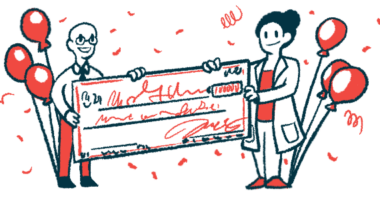3 Mistakes I Made During My First Year With ALS

Living with ALS has its challenges. For me, the first year after my ALS diagnosis was the hardest. Looking back, I made some mistakes and wasted time and energy that I wish I could have back again.
Although we each experience a different journey with ALS, I believe we all can relate to first-year mistakes. Following are three of mine and how I conquered them.
Mistake No. 1: I caused my ALS
Once I learned I had ALS, I spent many sleepless nights retracing my life trying to figure out exactly what I had done to cause it. Did I exercise too much or too little? Was it something in the air or the water? Did I zig when I should have zagged?
During the day, I’d scrutinize everything. Should I be eating this? Is it my soap? My shoes? Should I use only natural products? Deep down, I knew that self-blame was unproductive. Eventually, I decided that finding the cause of ALS was best left to the medical experts.
I’m sure glad I gave up on my need to know the why, because even now, 11 years later, the experts still can’t agree on the cause. Although the time I spent worrying is lost time I’ll never get back, I’m content that I found a way to accept my illness and live with a new perspective.
Mistake No. 2: I had a set expiration date
Hearing “terminal illness,” “no cure,” and “only two to five years to live,” has been described by many ALS patients as having the rug pulled out from beneath them. But it’s what we do with that knowledge next that matters most. Our mindset dictates how our lives unfold.
For example, my physical therapist recently shared with me his observations about how he’s seen patients react. “Two to five years? For some, them’s fightin’ words! But others simply shrug their shoulders, say OK, and then just waste away.”
I had my own limiting mindset. New clothes? Why bother? If I’m only going to be here for only a few years I’ll just wear out the ones I have. I was stuck in the ALS waiting room.
It was only when I reframed my diagnosis into a new, more positive, wellness-oriented approach that I felt able to contemplate having a future. Then I was able to reengage in life.
Mistake No. 3: Don’t tell anyone
Not only was I unsure about how to explain ALS to my friends, I was also embarrassed to tell them I had it. This goes back to my first point, of feeling guilt, and of thinking I somehow had a hand in causing my illness.
I also worried that my having ALS would change the relationships I had with my friends, or that I would lose these friendship altogether. I’ll admit, telling friends was hard for me. In fact, it wasn’t until the Ice Bucket Challenge in 2014, four years after my diagnosis, that I fully came out to extended friends and acquaintances.
My friends erased all my fears and apprehensions, making me wonder why I even worried in the first place. They became my best supporters and enjoyed helping me and cheering me on. I only had to let them know how they could help and what I needed.
Learning to live with ALS takes time. There’s a learning curve and we all go through the early phases of denial, guilt, limiting mindsets, and wanting it to just go away. The first step is to accept our illness. Then engage in life, reach out to our community of support, and know we are still the same person on the inside. Together, we can help each other learn to live well while living with ALS.
***
Note: ALS News Today is strictly a news and information website about the disease. It does not provide medical advice, diagnosis, or treatment. This content is not intended to be a substitute for professional medical advice, diagnosis, or treatment. Always seek the advice of your physician or other qualified health provider with any questions you may have regarding a medical condition. Never disregard professional medical advice or delay in seeking it because of something you have read on this website. The opinions expressed in this column are not those of ALS News Today or its parent company, Bionews Services, and are intended to spark discussion about issues pertaining to ALS.








Christopher Beutler
Interesting article. I have viewed my ALS as a gift of enlightenment. I have started an effective Buddhism practice and I make it my goal to put others first. I've done successful fundraisers, and I help those in need. For me, putting others first is the enlightenment I needed to bring value to my life and acceptance of my ALS.
Nicely written article, bringing anger to the diagnosis is not healthy nor does it bring any value to quality of life.
Dagmar Munn
Thank you, Christopher. You are correct in that the sooner we move past anger at our disease (and the world), the sooner we can re-engage in life. Bravo to you, for your service and support to others!
frankciampitt
i had on set in 2019 nov i just got married i came back from Florida i worked out all my life to be strong so i can get the many skills i had to be able to do i started losing weight 20lbs my weight lifting started to get harder i knew there was some thing wrong bad wrong i kept telling my new wife honey there's some thing wrong i was losing strength in my hands my tongue started to get holes in it i started having trouble breathing i had so many tests done this monster doesn't always show up on a emg its now sept 28 i have had the muscle spams twitching it hit me every where on my body i have been told its mda its muscle deconditioning one doctor told me that by my physical exam i have als wrote a letter i am so week now that i don't have the strength to do any thing everyone i tried telling says you don't have that i dont have the money to fight this all i have is Medicare pls if someone can help me in the direction i have to keep stop typing because my arms so week im on riluzole 50mg 2 times a day i live in south jersey thank you frank
Dagmar Munn
Frank, I am sorry to read of your increasing symptoms...thank you for taking the time and energy to share this. You asked for help, and I wonder if you have been in touch with the ALS Association for your state? Their ALS Care Coordinator can put you in touch with local support as well as answer your questions. Here is a link: https://www.als.org/local-support/chapters
Also, this is a very helpful website: https://www.youralsguide.com/newly-diagnosed.html
Dave Smiglewski
Great observations and wonderful of you to share this. I have struggled with letting folks know about my diagnosis a bit too but I told close family members and close friends first (as we all would do) but when I let it be known to the whole community where I am the mayor, in my weekly newspaper column, that I had ALS, it felt like a huge burden had been lifted off my shoulders. I no longer had to explain my slurred speech (the irony of that is worth another column) but there are still those clumsy moments when talking to occasional acquaintances or other mayor-colleagues who don't know my diagnosis. How do I bring this up, without changing the focus of our conversation onto my diagnosis? Should I bring it up al all, or just let them wonder about my speech, or if I have had a stroke (or been drinking)? often that has to be decided at the moment and on the fly and I often feel less than prepared to explain what may seem so obvious. It's a conundrum.
Again thanks for you inspirational notes and shining a light on the challenges we face.
Dagmar Munn
Thank you, Dave! I have the same challenge when speaking to someone who doesn't know I have ALS. Rather than ignoring it and letting the moment become awkward, I jump right in and say something like, "Please excuse my voice. I have trouble speaking. If you can't understand any of my words, just let me know and I'll repeat it." It helps the other person feel that it's Okay if they don't hear me clearly and ask for a repeat. I don't go into explaining ALS (unless they ask) and keep our focus on the conversation, not on me. Everyone I've encountered this way is accommodating and relieved. Hope this is of help to you :-)
Dave Smiglewski
Good to hear how addressing speech deficiency works for you. Thank you for the info and the suggestion. No doubt it will prove to be helpful.
carlos morales cardenas
Hola Dagmar: Soy Carlos, medico otorrinolaringologo.Tengo la sospecha de padecer ALS Inicie hace 2 y medio años con debilidad casi repentina de extremidades inf. y sup., debilidad facial. Noto progrsion de la debilidad de extremidades. Un tiempo tuve disfagia y cierta dificultad para hablar, que ha mejorrado.Lo importante es que tengo inhibiciones para comunicar lo que me pasa ,a mi familia.A mi esposa la entero de mis sintomas,pero solo escucha sin mayor comentario,lo cual me irrita y le digo que deberia procurar enterarse de lo que me ocurre. Ella no tiene un nivel medio o alto en cultura general y quiza sea por eso,porque en gral.nos llevamos bien.No me gusta hablar del tema con mis tres hijos,que ya son mayores(tengo 67 años) por no preocuparlos,como ocurre gralmente con los pacientes con enfermedades garves.He aceptado el posible diagnostico si se confirma.Se que los sintomas y signos clinicos son los mas importantes para el diagnostico,po eso me atrevo a hacerlo yo. No creo en el pronostico y creo que eso es positivo, pero cuando noto un pequeño avance de la enf, si me afecta animiicamente aunque me levanto rapido. Se que no tengo aun un sintoma mayor y sinceramente no se cual sera la reaccion. Ya comentare mas en otra ocasion,si me lo permiten, Gracias
Dagmar Munn
Hello Carlos, thank you for sharing. I am sorry you are experiencing these early symptoms and facing challenges telling family members. Please consider joining our patient forum here: http://alsnewstoday.com/forums/ We have many international members and everyone has a variety of ALS symptoms - - most importantly, you can ask questions and receive good answers from the members. You may also find my personal blog helpful as well. I cover many topics. https://alsandwellness.blogspot.com/2017/09/als-and-wellness-blog-archives.html
Best to you. I look forward to hearing from you in the future. Dagmar
Larry Berry
Your experience closely describes my experience. It is good to read an account so clearly written. Thank you.
I have bulbar ALS and therefore, have a PEG for most of my nutrition but still eat some. I actually chew for 1 hour on 'my supper'. I am aware of your belief in exercise and I too exercise ( walk 2 km per day and about 30 minutes of stretches and light weights). If an ALS patient loses muscle can they regain any of it back by exercising? The psychotherapist at the ALS clinic at the Ottawa Hospital is reluctant to answer the question. Also I think I am losing lung capacity and do one set of exercises to help. Do you have suggestions for maintaining or increasing lung capacity?
These are difficult medical questions. The answers my be 'hard' facts but better to know the truth than wast energy trying my own invented exercises.
Dagmar Munn
Larry, I "believe in exercise" for all who have ALS. It is simple logic that the muscles need therapeutic movement to maintain healthy blood flow. It is also helpful to our mood. Does it "cure" ALS? I don't think so. You ask about losing muscle... if it is full-on atrophy, exercising probably won't help. But losing strength? I have regained strength in my non-ALS-affected muscles. Here's an example: https://alsandwellness.blogspot.com/2020/02/the-power-of-just-one-chair-squat.html
And, this is how I maintain my lung capacity: https://alsandwellness.blogspot.com/2020/01/how-blowing-bubbles-helps-me-breathe.html I hope it will be of help for you too. Dagmar
Ann Speakman
Thank you for this! I’ve been living with ALS for almost a year now - and this describes exactly how I’m feeling. It made me cry to know that I’m not alone in those feelings. I struggle with “what’s the point” with everything having to do with taking care of myself, exercising etc. I am a Christian and I feel God is by me - leading me but I keep waiting to feel better - normal. I know it won’t happen but you give me hope.
Cathleen Harden
Thanks for sharing, Im also in my 1st year and I struggle with telling ppl. I think because I don't wanna be treated differently or maybe they don't care. Either way my goal is to focus on living
Dagmar Munn
Bravo, Cathleen!
Tom
My Wife was diagnosed with ALS. No specific test rather a process of elimination for what it could be or not be. She was diagnosed with the Bulbar version ... survival is shortest among that group. Out of the 3 reasons/mistakes you provided, only the #3 was the one my wife was guilty of. She also did not want toi share her illness with others with myself as the exception. She was a REDHAT chapter Queen of her social group. After about a year, it was obvious she had issues. From actual diagnosis to death, was about 2 years. At first, speech clarity was getting worse, then swallowing, then limb involvement, then breathing, Trach-ventilator, Enteral Feeding.- stomach tube. The two of us couldn't keep up with the accelerated decline vs alternatives for living modifications. She deserved a Medal of Honor as an inspirational fighter, "Never Give Up". She was that way to the end. I've never recovered from that experience. Her suffering & death is a part of me that I carry every day. I wish you the best & make every day count for something.
Dagmar Munn
Tom, I am so sorry for your loss. Yes, everyone experiences different timelines and journies with ALS. It is so good that she had you to love and support her. Best wishes to you.
Rita Lepper
I was diagnosed with ALS a little over a year ago. I, too, struggled with self blame, and still sometimes wonder how I might have contributed to the disease process. I have to remind myself that self blame isn't going to reverse ALS.
I remember texting my kids, just moments after the diagnosis. The next day I posted it on Facebook, requesting prayers. I was overwhelmed with the outpooring of love and prayers that I recieved and still recieve. I haven't regretted letting people know through social media. It gave people time to think before responding.
Before the Covid shutdown of the fitness center I attend, I walked a minimum of 10,000 steps per day. I also took 10 to 12 fitness classes per week. After the center reopened many of the classes were never started up again, because of lack of instructors. It was about that time that I developed foot drop and eventually saw my CNP, who immediately referred me to a neurologist. I now do only 4 to 5 classes a week, 3 of which are only a half hour length. I do physical therapy once a week. The only walking I do is what I need to to get places or to work in my yard. At 70, I think I am still more active than most people my age.
Fortunately, my progression has been slow. I like to think it has something to do with my being active.
It's funny you should mention the clothes thing. I had just the opposite thought. I wanted to buy more, I wanted to look as good as possible. Also, after being less active, I started putting on more weight, so had to buy new stuff, or wear very tight clothing.
Thanks for you article.
Nada Nassuhy
my friend was unfortunately misdiagnosed and it took her almost 8 months to discover that she had ALS and the one who helped her to identify that was an online platform called docspert health that connected her with international doctors, treatment plan was given so she didn’t need to go anywhere or travel abroad. Also, connected us with support groups